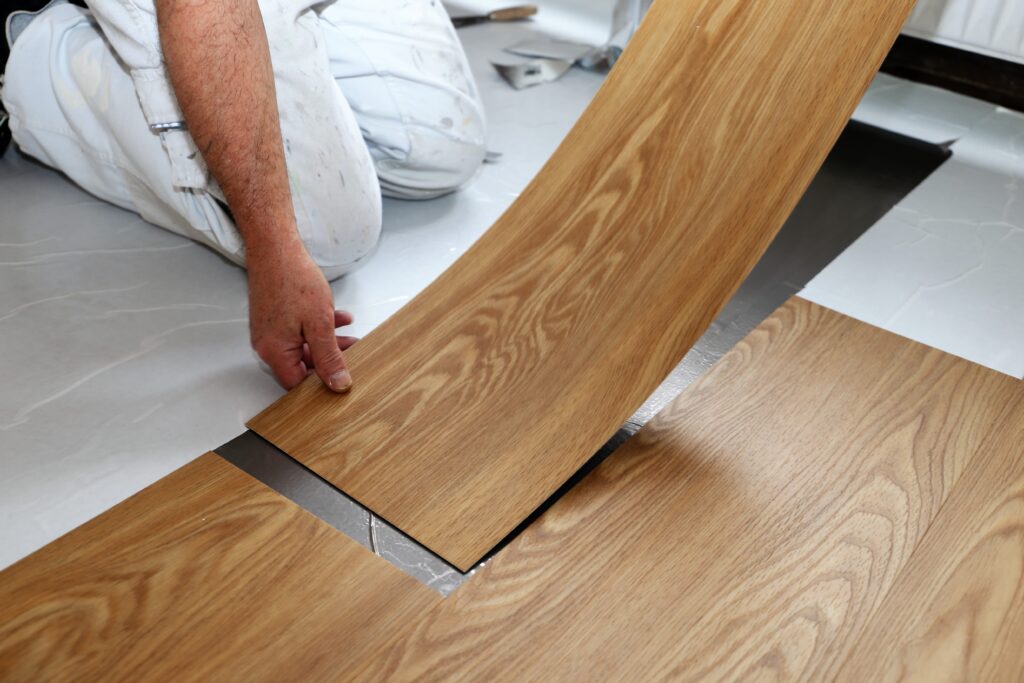PVC Flooring

Polyvinyl Chloride (PVC) is the most widely-used plastic material for building and construction products such as pipes, cables, flooring, and roofing, according to the European Council of Vinyl Manufacturers (ECVM).
“PVC is the third largest-selling commodity plastic in the world, after polyethylene and polypropylene,” according to ECVM. PVC is durable and requires less replacement and maintenance. Often known as “vinyl,” this durable material, for instance, is used in the siding of homes because it doesn’t require the maintenance compared to using wood panels that can degrade over time and require painting, not only for aesthetic purposes but to protect the wood. In addition to being used across commercial industries, PVC is also found in children’s toys, clothing, and consumer packaging.
Whether used in the construction of our buildings, consumer goods or discarded in our environment, this popular material has been increasingly scrutinized over the years as a contributor to health-related illnesses, environmental degradation, and human rights abuses. “One of the industries we are looking at a lot these days is plastics; whether it’s being produced in the U.S. or overseas, these plastics have all those impacts,” said Jim Vallette, Co-Founder and President of Material Research L3C, which investigates supply chains that impact human health, human rights, and the planet during a panel discussion at Design for Freedom Summit at Grace Farms in 2023.
“Climate change, toxic pollution, human rights abuses, every supply chain is going to be following the path of lease resistance if it’s left unchecked,” he added. The Summit was attened by more than 500 leaders across the ecosystem of the built environment.
About 7 billion pounds of PVC is discarded in our environment per year in the U.S., alone, according to the EHS (environment, health, and safety) Daily Advisor, a resource for best practices for environment, health, and safety professionals.
“Improperly discarded PVC constitutes a substantial proportion of ocean litter and poses especially significant threats to human and environmental health. Even before the production of this material began to accelerate in the 1930s, researchers suspected that PVC’s primary building block, vinyl chloride, produced toxic effects in laboratory animals,” according to the EHS article.
In facilities where PVC is produced, workers are at risk of exposure primarily through the inhalation of the colorless gas or vinyl chloride that is primarly used to make PVC, according to the National Cancer Institute, a division of the U.S. Department of Health and Human Services. This exposure is associated with an increased risk of cancer including liver, brain, and lung cancer.
Despite these concerns, however, the consumption or use of PVC continues to rise. In 2016, the consumption volume of PVC was 42,931.1 thousand tons and it was forecasted to increase to 55,715 thousand tons in 2022, according to Statista. In terms of top importers of PVC, India followed by China, are among the leading importers of the material, $1,323 million and $848 million, respectively.
China, besides being a major importer of PVC, the country also manufactuers vinyl products used in construction such as vinyl tile or flooring. This tile, often sold in major big-box retaliers in the U.S., is reportedly being made in Uyghur forced labor in its factories, according to The Intercept.
One of the projects Vallette worked on involved working with the Healthy Building Network (HBN) to catalog the entire PVC industry worldwide, so that flooring producers and other PVC producers would know where it’s coming from, he said. HBN is a leading-edge organization that informs industry practitioners on healthy building practices to increase transparency in building products, reduce human exposures to hazardous chemicals, and create market incentives for healthier innovations in manufacturing.
The “PVC can come from all sorts of different toxic technologies. In that inventory, we saw what was not reported anywhere, which was a massive migration of PVC resin manufacturing to the [Xinjiang] region in China.” In June 2022, Vallette, along with co-authors, Laura T. Murphy and Nyrola Elimä, released a ground-breaking report Built on Repression, PVC Building Materials’ Reliance on Labor and Environmental Abuses in the Uyghur Region, which investigates the increased manufacturing of PVC through state-sponsored labor transfers in China’s Uyghur Region and how these building materials make their way into international markets.
Other organization, such as Plastics Today, referencing the use of Uyghur forced labor involved in making PVC, advises those purchasing these products from China, to reconsider sourcing PVC materials from other countries.
Vallette, however, reminds us that we’re all part of that same “tapestry.” Since 2019, with his company, Material Research, he’s been working with community groups, NGOs, and reporters around the world. “We see these all being, you know, in the same tapestry, climate change, toxic pollution, human rights abuses,” he said.
“Our communities in the U.S. are in the same tapestry as the communities in the Congo.”
Further resources:
Sheffield Hallam University report “Built on Repression”